Mark and I absolutely love Moroccan food! The cookery is influenced by the country’s interactions with other cultures over hundreds of years. There are flavours of Berber, Arabic, Andalusian, European, Sub-Saharan, and Mediterranean traditions, all blended into one delicious cuisine. From delicious meaty stews with added dried fruit, to barbecued brochettes, to spicy soups, to fresh fish and seafood, to vibrant salads, to creamy milkshakes, to sticky-sweet pastries and doughnuts, Morocco has something for everyone to enjoy.
We ate so many amazing dishes during our tour around Morocco. In this post, I want to introduce you to our favourites and share some recipes with you so that you can create Moroccan food in your own kitchen.
In this article
Couscous
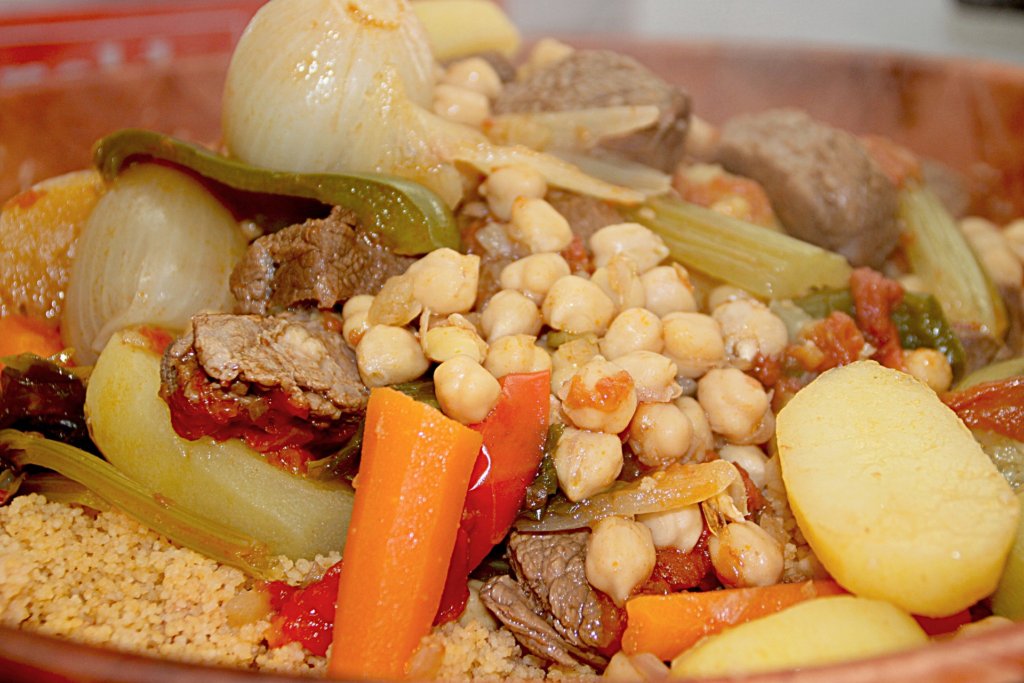
Couscous is a staple of Moroccan cuisine. It is originally a Berber dish made of semolina grains, usually served topped with vegetables and meat cooked in a delicious, flavourful, comforting broth. The couscous served in Moroccan homes is a million miles away from the commercially-produced dried variety we’re used to buying from the supermarket. Rather than a quick five-minute soak in boiling water, home-made couscous is prepared with love and the whole process takes a couple of hours!
We learned how to prepare couscous properly from Rashida, our host at La Colombe Blanche in Moulay Idriss. It was fascinating to watch. She explained to us how, as a child, she loved to help her mum make couscous from scratch. She would make a dough with semolina flour and water and then push it through a purpose-made sieve. The tiny pellets of dough were then dried in the sun. The sound of the dough being sifted was ‘ksss, ksss’, which is probably why the grains and then the dish came to be called couscous!
Nowadays, few Moroccan women make their own grains, but they do still lavish a lot of care and attention on the ones they buy from the shop. Rashida told us that any couscous should be prepared by steaming it, even the ‘instant’ variety we typically use. Having tasted the results, I can see why! The granules absorb a lot more moisture and you end up with plumper, more tender, fluffier couscous.
Rashida used a two-part cooking pot called a couscoussière. The bottom part is a deep pan which holds the steaming liquor. Depending on what dish the couscous is for, this could be water, stock, or the broth with meat and vegetables that will make up the main meal. The top part is a flat-based colander that fits tightly above the pot. If you don’t have a couscoussière, you could use a regular or bamboo steamer, or even a colander on top of a normal saucepan. The important thing is that it fits snugly so that no steam can escape. The idea is that all the steam rises through the couscous. To ensure this happens, you could seal the seam between the colander and the pot with a strip of cloth dipped in a flour and water glue.
How to Prepare Couscous the Moroccan Way
- Heat your water or stock in the pot. Bring it up to a simmer.
- Moisten the couscous with a cup of water and a little olive oil.
- Rub the granules between your fingers to separate them.
- Pour the grains into the colander and place on top of the pot.
- Steam for one hour.
- Pour the couscous into a large flat bowl and stir with a large metal spoon to separate the grains. Add a little water (flavoured with spices if you wish).
- As soon as the couscous is cool enough, use your hands to rub the granules gently against each other. Lift them out of the bowl and allow them to fall back in. The idea is to aerate and separate the grains. Make sure there are no clumps remaining.
- Return the couscous to the colander and steam for another 20 minutes.
- Repeat steps 6, 7 and 8.
- By now, the grains should have swelled to three times their original size.
- Pour the couscous into a large, flat serving dish. Make a hole in the centre for the meat and vegetables.
- Serve and enjoy!
Watch this video which further explains the process we saw in Rashida’s kitchen:
Check out this recipe for authentic Couscous with Lamb and Vegetables by Moroccan chef, Mohamed Ben Mchabcheb.
Tagine
After couscous, ‘tagine’ is generally the word most associated with Moroccan food. A tagine is the iconic conical earthenware pot, with a wide, shallow base for maximum heat distribution and a cone-shaped lid to condense the steam back into the food. It is also the name of the dish that is cooked in it. Aromatics, herbs, spices, vegetables, and proteins are layered with oil and water. As the mixture cooks, a stew-like consistency develops, making a deliciously rich, flavoursome sauce that is often mopped up with bread.
Tagines are found all over Morocco and come in vegetable, lamb, chicken, meatball, or fish varieties. It is the ultimate one-pot cooking.
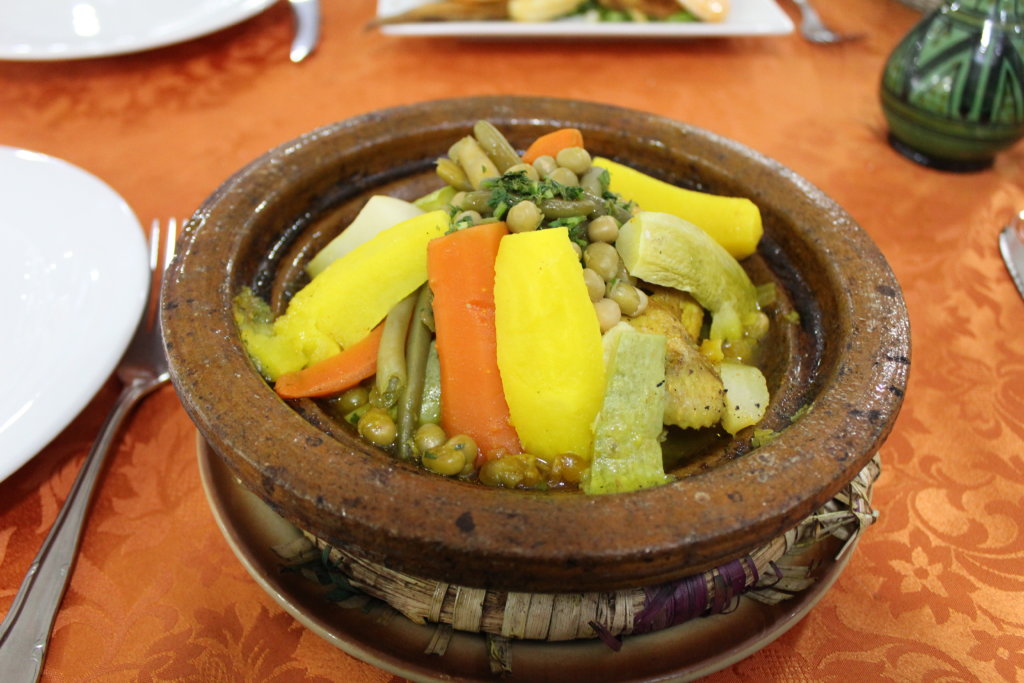
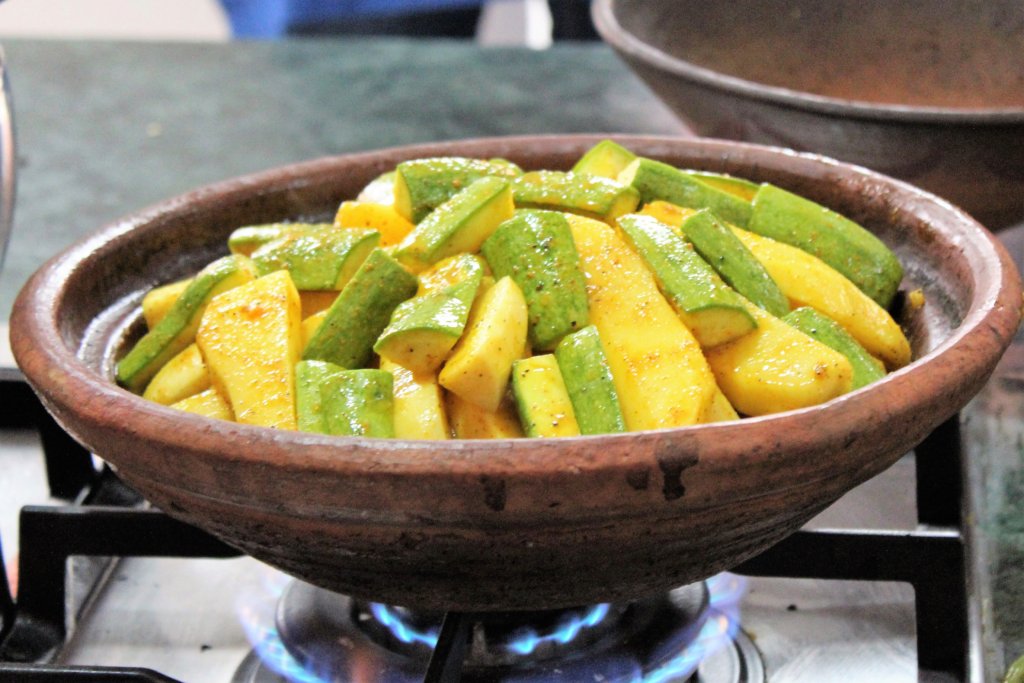
How to Make a Tagine
Whilst we were in Morocco, we were lucky enough to learn how to make tagine at a cookery class in Marrakech. These are the basic steps:
- Place a layer of thickly sliced red onion across the base of the tagine to create a bed for the rest of the ingredients and to stop the meat from sticking to the bottom of the pot and burning. In fish tagines, the onions are often substituted with celery and/or carrots.
- Add garlic. This can be crushed or left whole.
- Sprinkle with oil.
- Arrange the meat or fish in the centre.
- Add half of your spices. These are usually a mix of salt, pepper, cumin, turmeric or saffron, ginger, cayenne, coriander, and paprika. Some recipes suggest that you mix the spices together first and coat the meat and vegetables in them before adding to the tagine.
- Add some more oil.
- Peel and shape your vegetables. These could include potatoes, sweet potatoes, carrots, courgettes, and parsnips.
- Arrange the prepared vegetables in a conical shape around the meat.
- Add the rest of your spices.
- Add some more oil.
- Top the vegetables with your garnish – olives, slices of sweet pepper, pieces of preserved lemon, or whole chillies.
- Add water or stock.
- Place the tagine over a low heat and slowly bring up to a simmer.
- Leave to cook. A lamb or beef tagine can take up to three or four hours depending on the size. Fish, chicken, or vegetable tagines won’t take as long.
- Halfway through cooking, check whether the tagine needs more water.
- Once the meat and vegetables are tender, serve your tagine!
Watch this video to learn how to make a vegetable tagine:
Click here for 10 incredible Moroccan tagine recipes.
Chicken with Preserved Lemons and Olives
This is one of my favourite Moroccan recipes. I love the tangy, salty lemons with the soft chicken. Our driver’s sister prepared it for us when we spent the evening in her home in Tangier whilst we waited for the night train to Marrakech. It was delicious!
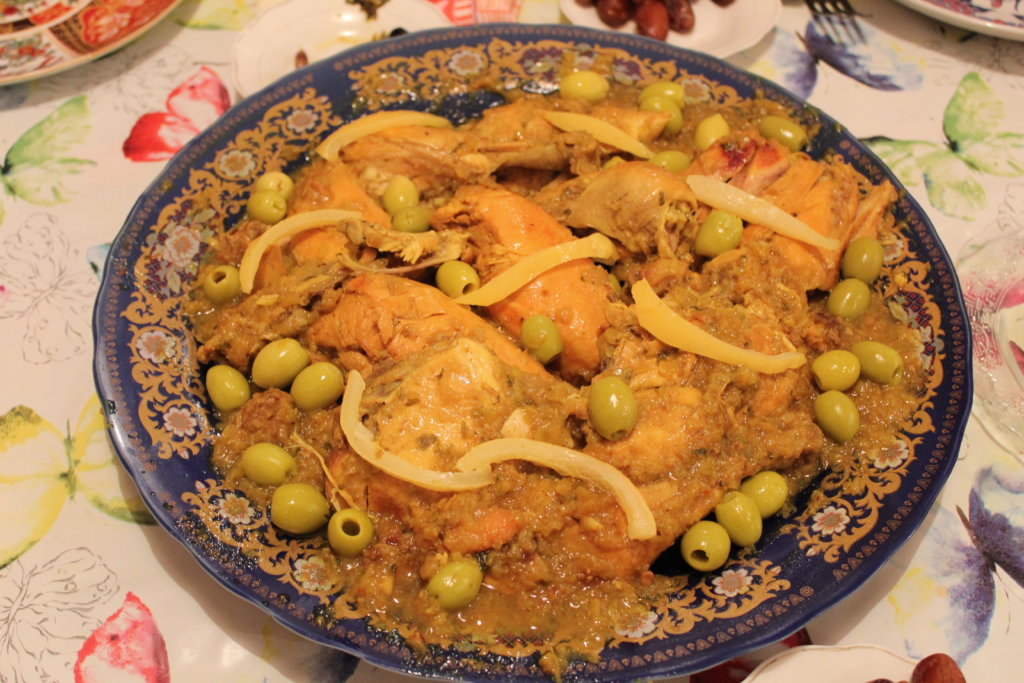
Watch this video to learn how to prepare the dish at home:
Click here to read a recipe for chicken with preserved lemons and olives.
Lamb or Beef with Prunes
I love the way Moroccan cuisine combines meat with dried fruit. From the chicken with lemons described above, to the rabbit with apricots we enjoyed in Chefchaouen, to the tasty red meat with prunes you find all over Morocco, these dishes are hearty, comforting and delicious.
Watch this video which teaches you how to prepare beef with prunes at home:
Click to read a recipe for lamb or beef with prunes here.
Shakshuka (Berber Omelette)
There are many variations on Berber eggs or Berber omelette. All are delicious. They are great for breakfast or lunch and are usually served with freshly-baked bread. We enjoyed the one pictured below at the gite we stayed at in Aroumd in the High Atlas Mountains. I think the altitude made it taste even better than usual!
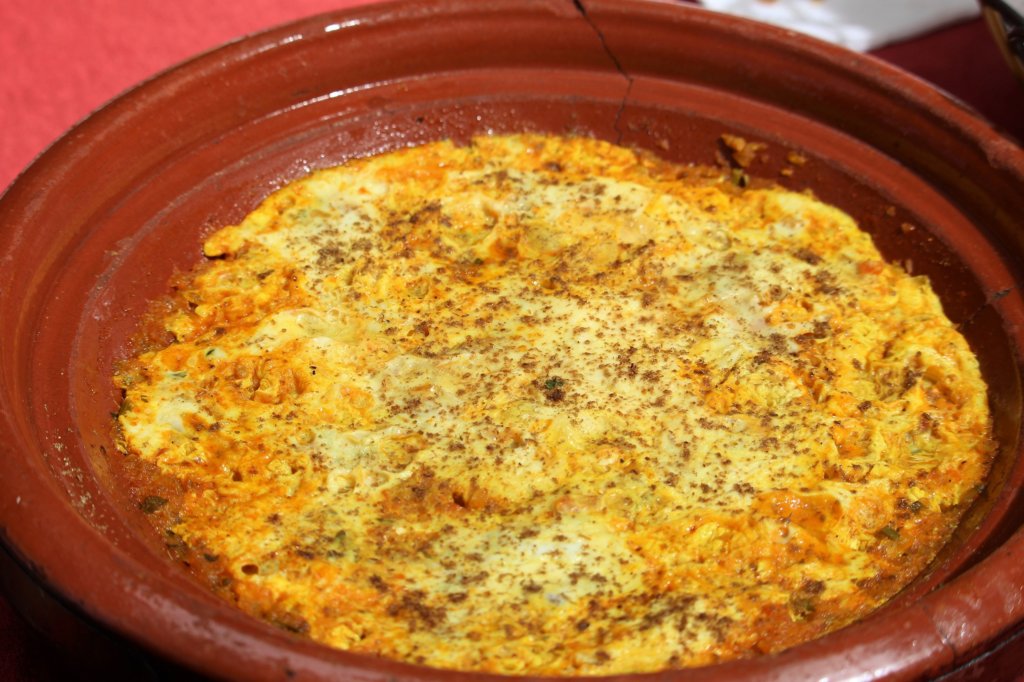
Read this recipe for Berber omelette similar to the one pictured, or watch this video for the type of Berber eggs which are poached in a rich tomato sauce:
Harira
Harira is a spicy tomato, chickpea and lentil soup served all over Morocco – at home, in restaurants, and at street stalls. Sometimes, meat is added to make it into a main course dish. It is usually eaten with dates and sweet pastries on the side. We were served it all over Morocco, but never with more enthusiasm than by these guys during our food tour of Marrakech!
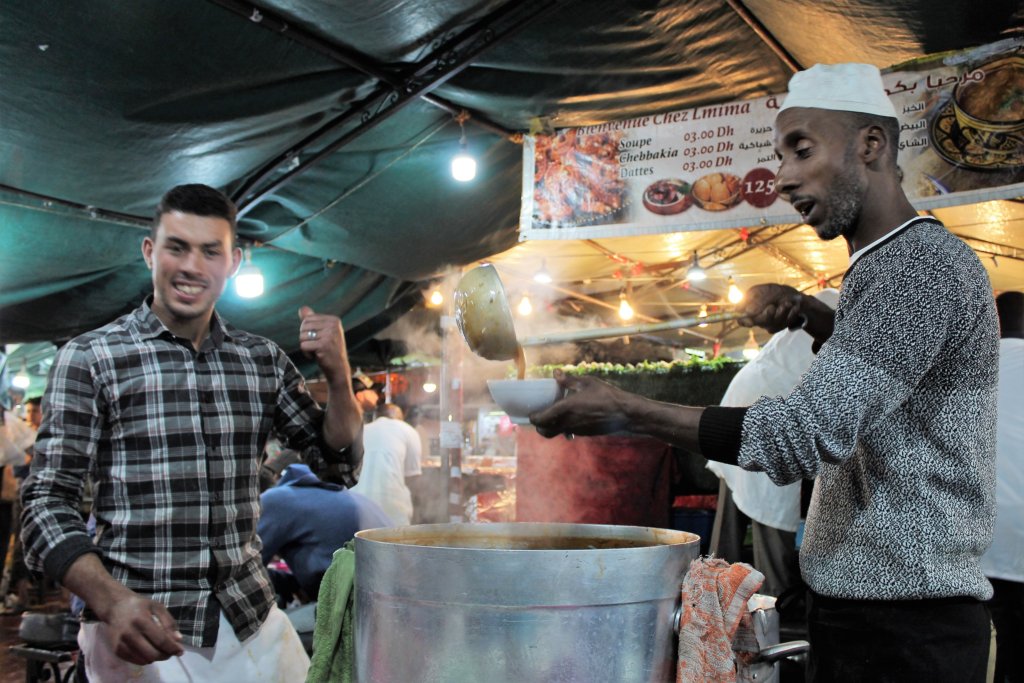
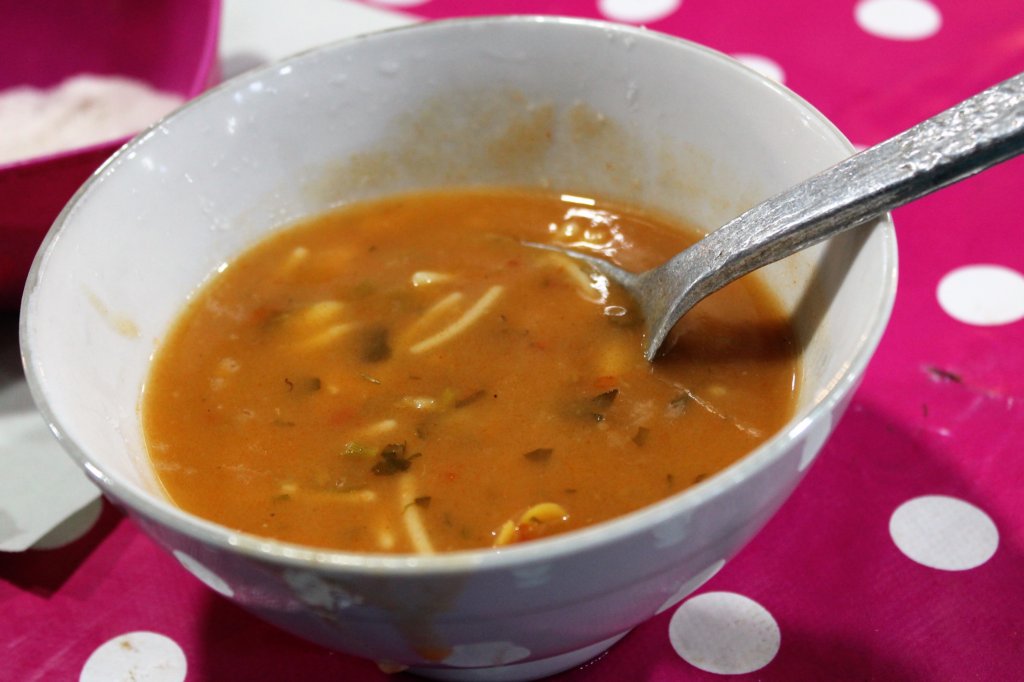
Click here for a delicious harira recipe.
Fish Chermoula
Chermoula is a herby, spicy marinade which is used widely in Morocco to flavour white fish as it cooks. The result is delicious.
Watch this video to learn how to make it at home.
Mechoui (Roast Lamb)
Mechoui is melt-in-the-mouth, fall-off-the-bone roast lamb. In Morocco, it is traditionally prepared by roasting a whole lamb either on a spit over a fire or in a pit in the ground, as it is done in Mechoui Alley in Marrakech. The meat is seasoned with salt and cumin and served with flatbread.
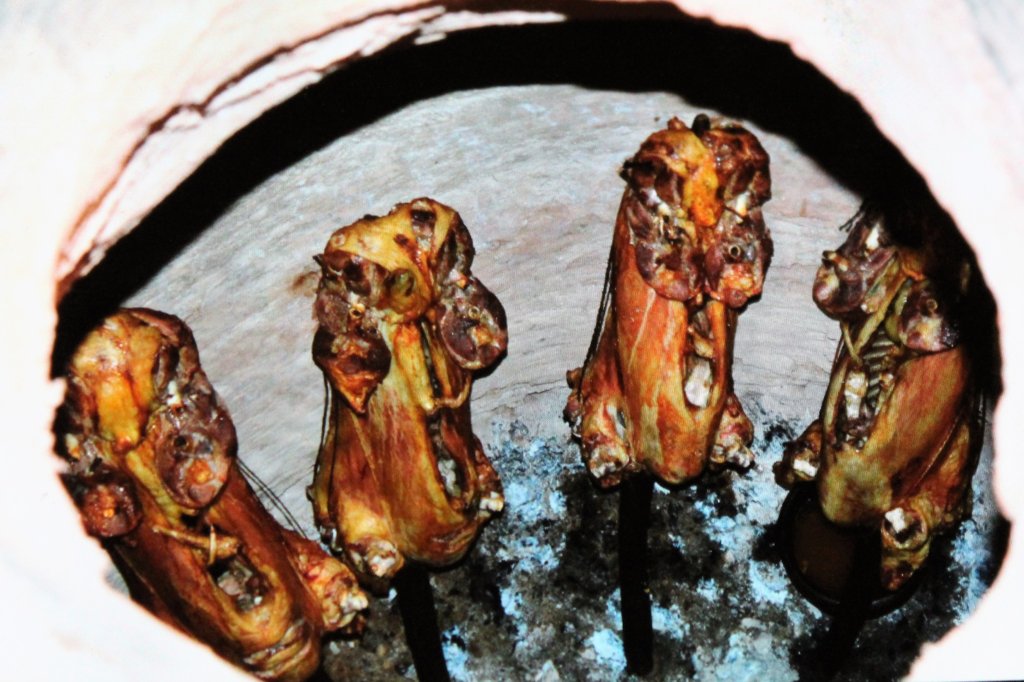
Click here for a recipe for preparing mechoui at home.
Sardines
Moroccan food includes a lot of fish, especially in the coastal town of Essaouira. Here, we enjoyed many fish dishes. The best of these was probably simple barbecued sardines. These often underrated fish are cheap, plentiful and delicious.
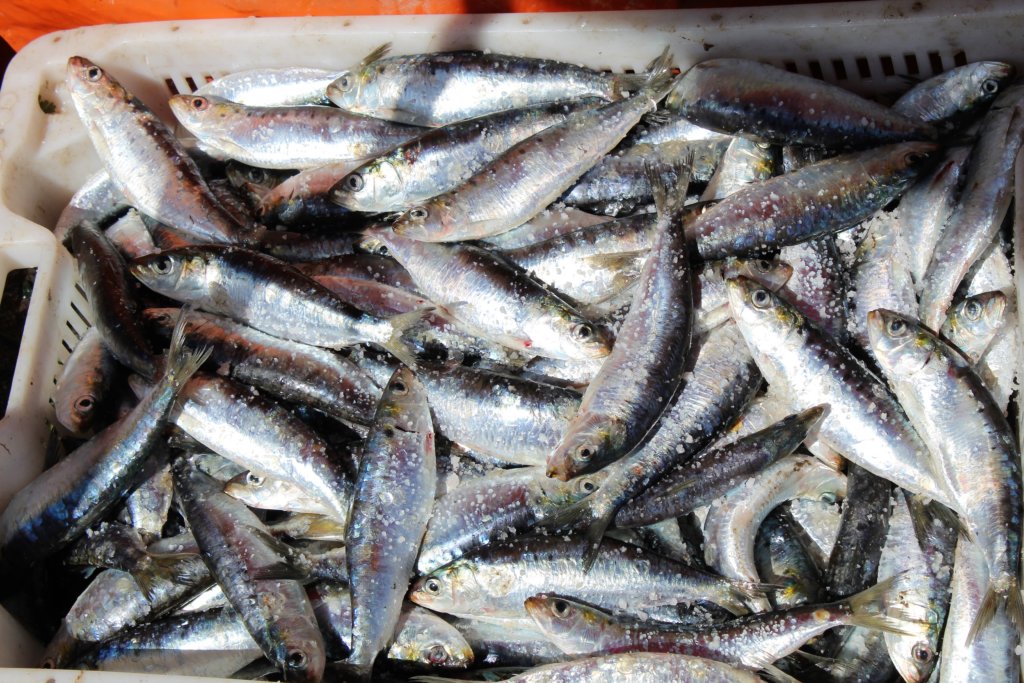
Read a recipe for Moroccan sardines here.
Khobz
Khobz is the ubiquitous Moroccan white bread shaped into flattish rounds and served at every meal as an accompaniment to almost every meal. It doesn’t keep well, so women often bake it or buy it twice a day. It’s common practice to make the bread at home and then take it to a central oven to be baked.
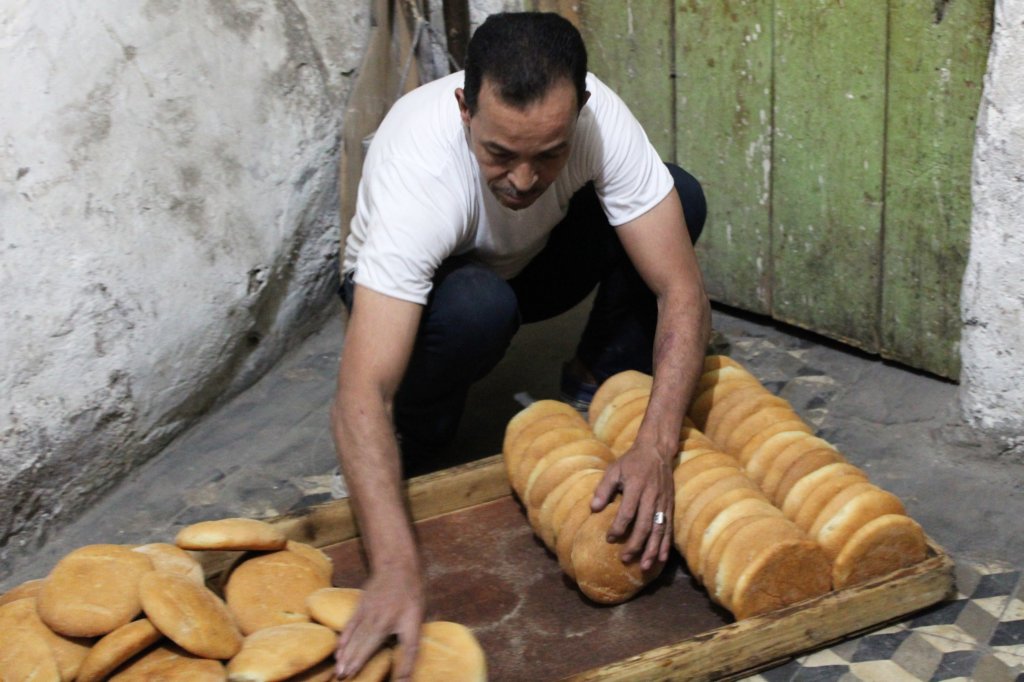
You’ll find a recipe for khobz here, or you can watch this video to see how it’s done in the traditional way over an open fire.
Zaalouk
Zaalouk is a tasty cooked aubergine and tomato salad. It is served as a dip with fresh bread or as an accompaniment to many main dishes. Authentic zaalouk takes a long time to prepare, as we found out during our cooking class in Marrakech, but it’s worth it!
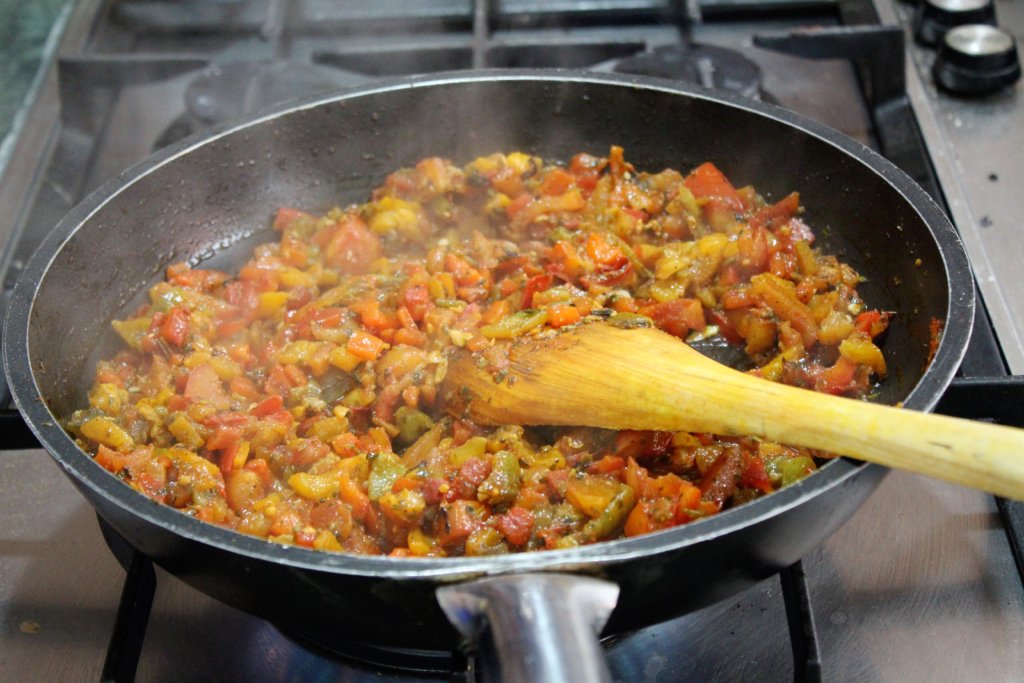
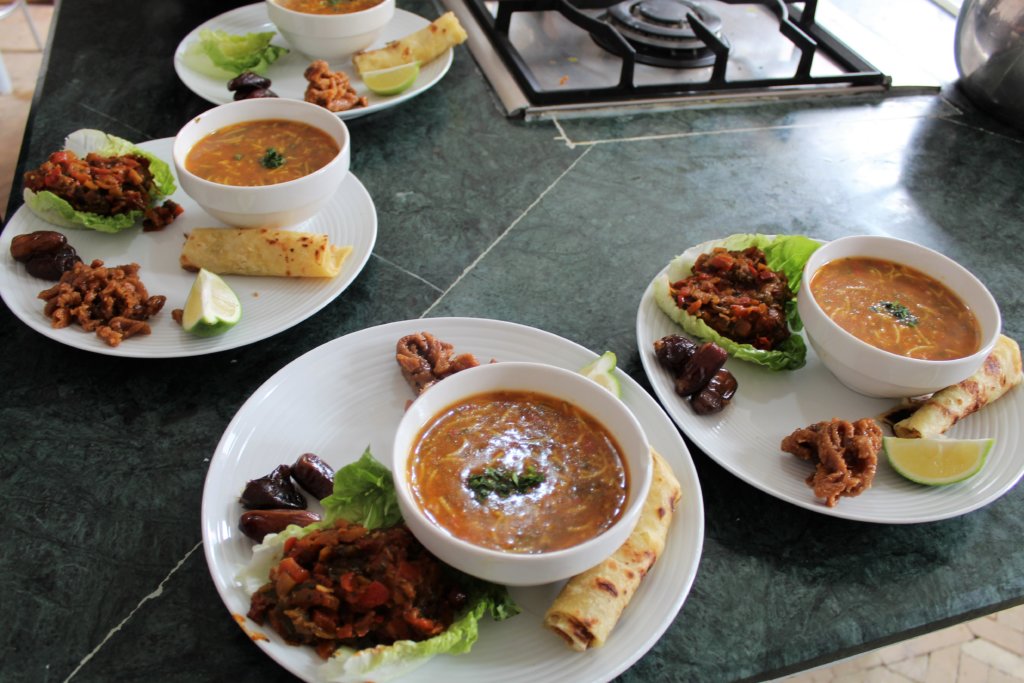
Click here for an easy-to-follow recipe to make zaalouk at home.
Pastilla
Pastilla, or bastilla, is a sweet and savoury pie originating from Fez in Morocco. The filling is traditionally made with pigeon but chicken is often used today. The meat is cooked, shredded and combined with spices before being wrapped in layers of filo-type pastry, covered in sugar, and baked. The sweetness is an acquired taste – one that I quite like, but that Mark really can’t stand!
Watch this video from Gordon Ramsey to see how to make a simple pastilla at home.
For a more authentic recipe, click here.
Maakouda
Maakouda are delicious spicy potato fritters made at home and served as a starter or, more commonly, bought on the streets to eat as a snack – the Moroccan equivalent of a bag of chips!
They are made by flavouring mashed potato with herbs and spices, forming it into balls or small patties, and deep-frying them. They are served on their own in a paper cone or in a sandwich with salad. Not very healthy, but extremely tasty!
Click here for a recipe.
Bissara
Bissara is a popular soup made from broad beans. It is a Berber dish and is often eaten for breakfast in winter by the nomads of the mountain and desert regions.
Read the recipe here.
Snail Soup
Ghoulal, or babbouche in French, is an earthy broth containing boiled snails. It’s sold on the streets of almost every town and city in Morocco. Some would say it’s one of the must-try foods when you’re visiting the country. I passed when we were given the chance to try it in Chefchaouen. Having spent many years living in France, I already know that I’m not keen on the taste or texture of escargots!
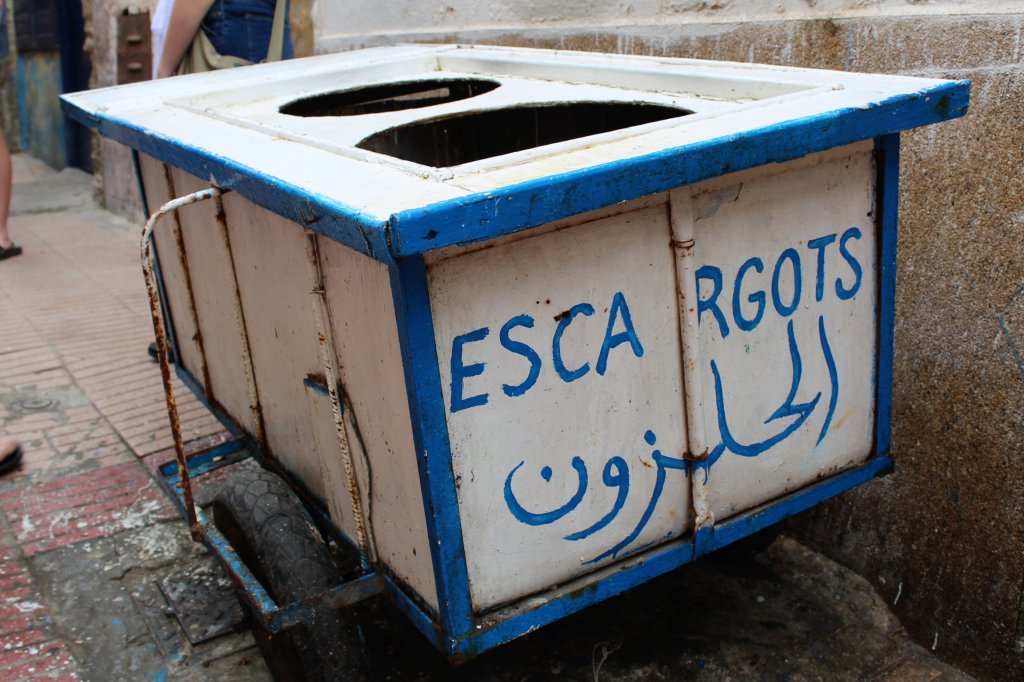
Tanjia
Not to be confused with ‘tagine’, tanjia is a meaty stew particular to Marrakech. The Greek urn-like pot it is cooked in is also called a tanjia.
Most tanjias today are made with beef, but lamb, chicken, or camel can also be used. A traditional tanjia has no vegetables. The meat is flavoured with herbs, spices, dried fruits, garlic, and lemon. You add water, olive oil, and a handful of smen, a salty type of butter similar to ghee, and cook it very slowly.
Tanjia is often referred to as the bachelor’s dish because it has simple ingredients and is very easy to prepare. Traditionally, it was made by men who worked in Marrakech’s souks as a picnic dish for when they gathered to socialise in the city’s parks on Fridays, their only day off. They didn’t even have to cook the tanjia themselves. They took their filled pots to the local hamman where the bathhouse workers would put them in the hot embers used to heat the water. They would leave them there to simmer away, usually overnight on a Thursday.
The best way to replicate this today would be in a slow cooker.
We made a lamb tanjia at our cookery class in Marrakech and enjoyed several others while we were in Morocco. They were especially delicious for meat lovers like us!
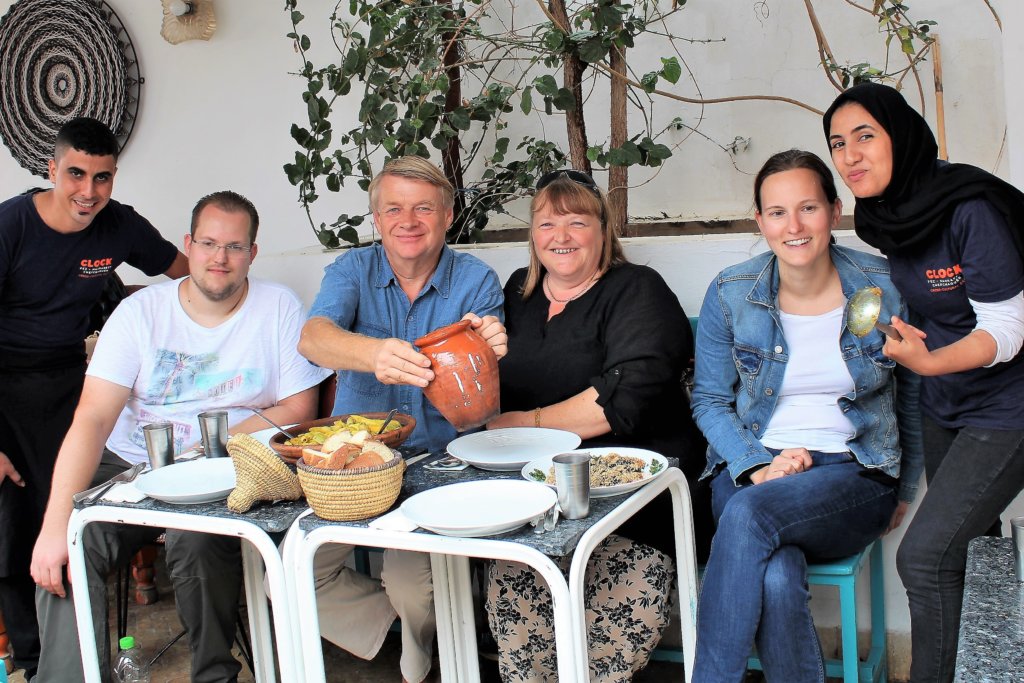
Watch this video to learn more about the importance of tanjia to the people of Marrakech.
Here is a recipe so that you can prepare tanjia at home.
Kaab el Ghazal
The literal translation of the Arabic term kaab el ghazal is ‘gazelle ankles’, but these traditional Moroccan pastries are more commonly referred to as ‘gazelle horns’ in English (cornes de gazelle in French). These delicious crescent-shaped cookies are filled with almond paste flavoured with orange blossom water. They are expensive and are often served on special occasions such as weddings.
We bought some from the famous Patisserie Bennis Habous in Casablanca during our walking tour of the city. We ate them at a nearby café, washed down with refreshing mint tea. They were amazing!
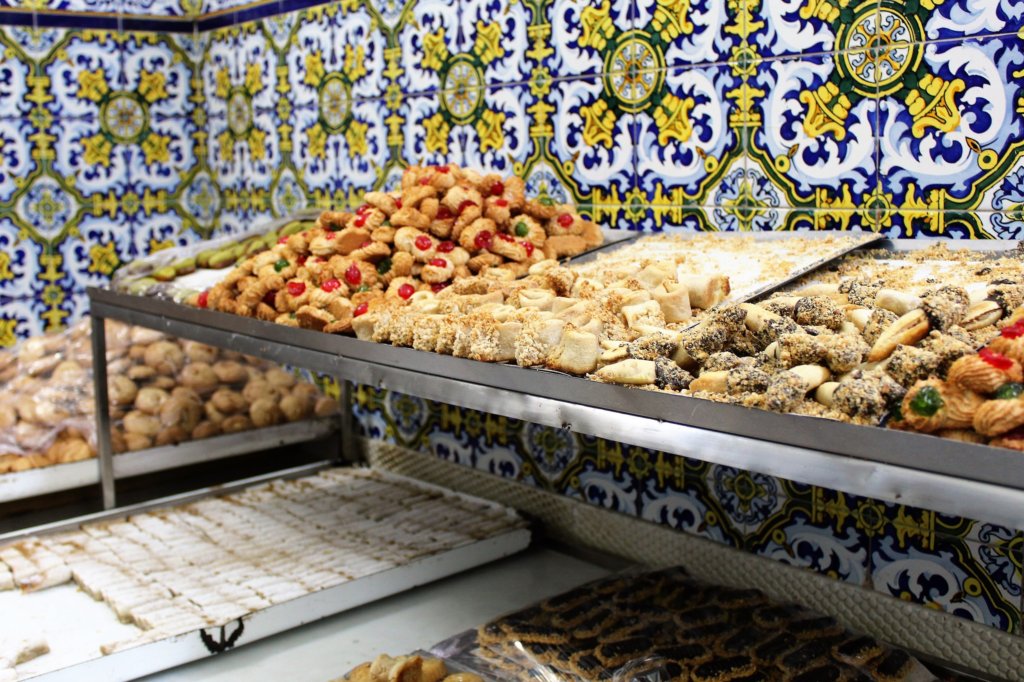
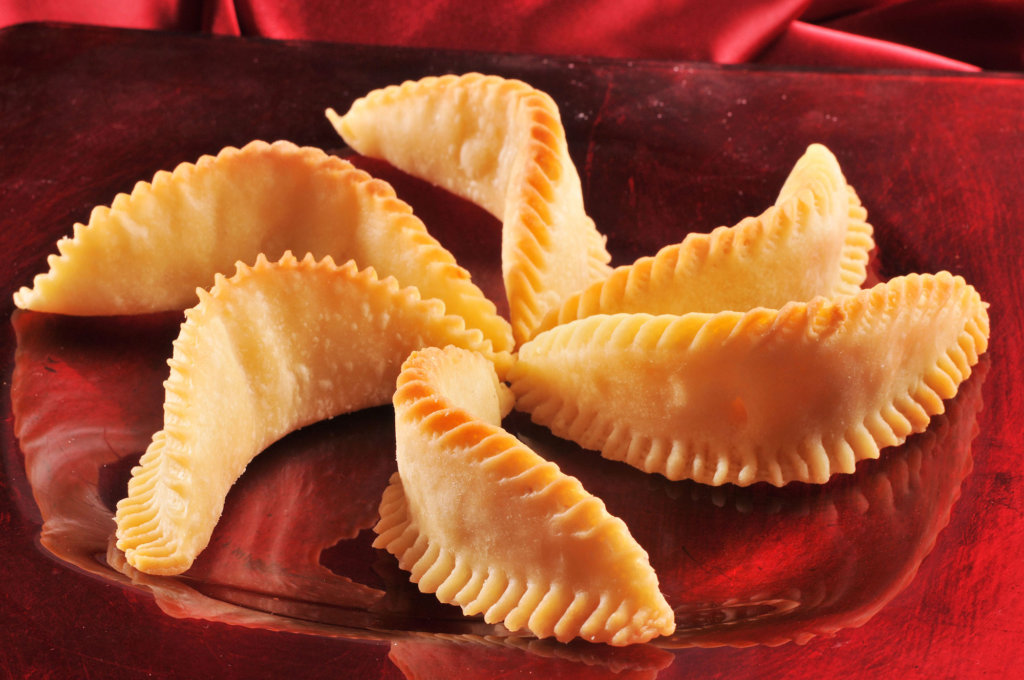
Click here to get the recipe.
Sweet Pastries
As I’ve alluded to before, Moroccan people generally have a very sweet tooth! Sticky, syrupy pastries are served everywhere for every meal, and at any time in between! They are presented as an accompaniment to hot spicy harira soup, on your saucer when you have a mint tea, with your coffee after dinner, or simply as a snack as you’re shopping in the souk.
There are countless varieties of sweet pastry making up colourful displays in the markets of Marrakech and other towns and cities. Shapes include spirals, triangles, rounds, crescents, and stars. They are flavoured with ingredients such as almonds, orange, pistachios, honey, sesame, cinnamon, rosewater, and, my favourite – dates! Some are made with a cookie-like dough, but most use filo pastry to give a deliciously crispy texture.
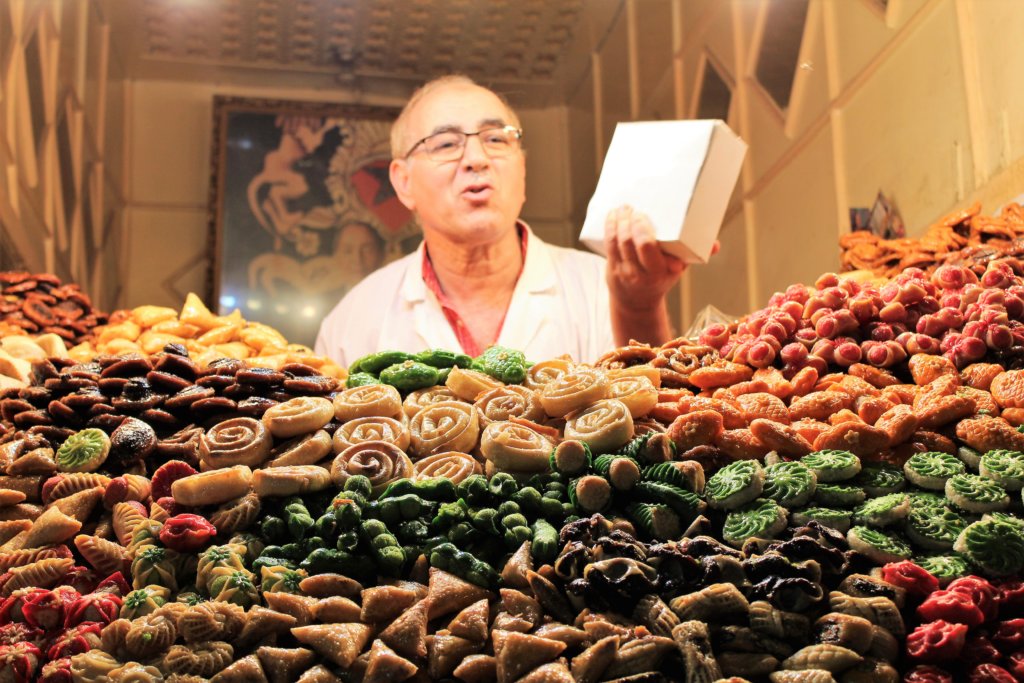
We made these blighat b t’mer (date spirals) during our cookery class in Marrakech. Later, we shared them with our fellow travellers. They didn’t last long – they were incredibly moreish!
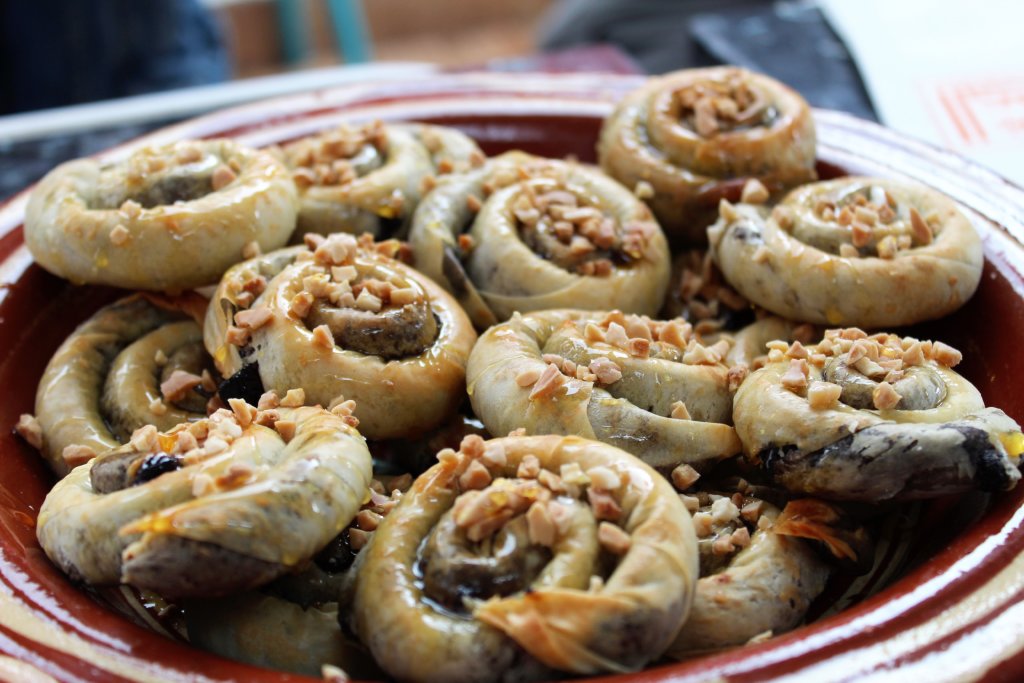
Here is a recipe for almond briouat pastries if you want to have a go at home.
Book a Cooking Class in Morocco
READ MY COMPLETE MOROCCO TRAVEL GUIDE
Further Reading About Moroccan Food
Check out my Moroccan food colouring books!
Unlike most colouring books on the market, mine, suitable for both adults and older children, are full of line images created from photos I have taken on my travels. This means that they are highly detailed. They are not line drawings where you can colour between every line. The pictures invite you to be creative. Apply a colour wash with watercolour. Use coloured pencils to create texture. Blend colours together. Add detail with a fine ink pen. The choice is yours! Create your own work of art! When you’re happy, remove it from the book. Stick it on the fridge as a reminder of a place you’ve already been to or somewhere that’s on your bucket list. You could even get it framed. Display it on the wall for people to admire.
If you like what you’ve read, PIN IT!!
When you are next travelling, please use these links!
I know none of us are travelling at the moment, but when this craziness is over, please use these links when making your bookings. These are the companies we use. It won’t cost you any extra, but we will earn a few pennies to help keep Happy Days Travel Blog going. Thank you!!
- Book your travel insurance with World Nomads (Never leave home without protecting yourself, your trip and your belongings!)
- Book your flight with Skyscanner
- Book your accommodation with Booking.com
- Book a tour with Tour Radar or Intrepid Travel
- Book city tours and activities with Urban Adventures or Get Your Guide
Disclosure: This post contains affiliate links. If you click through for more information, or to make a purchase, it may result in a small commission coming my way. Please note that there is no extra cost to you associated with this. Thank you so much for supporting my site.
Join our mailing list

Sign up to receive our monthly newsletter. Keep up with what we're doing and be the first to receive special offers and insider tips.

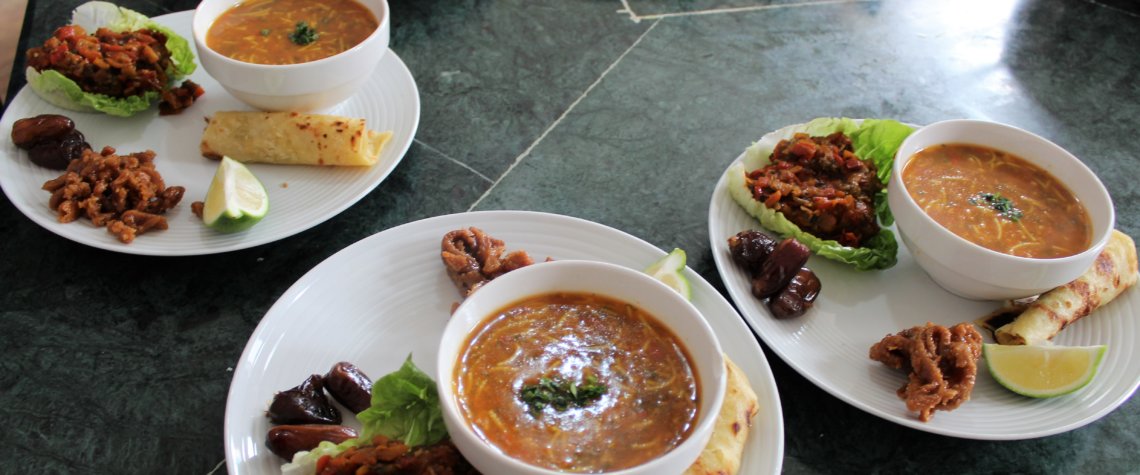

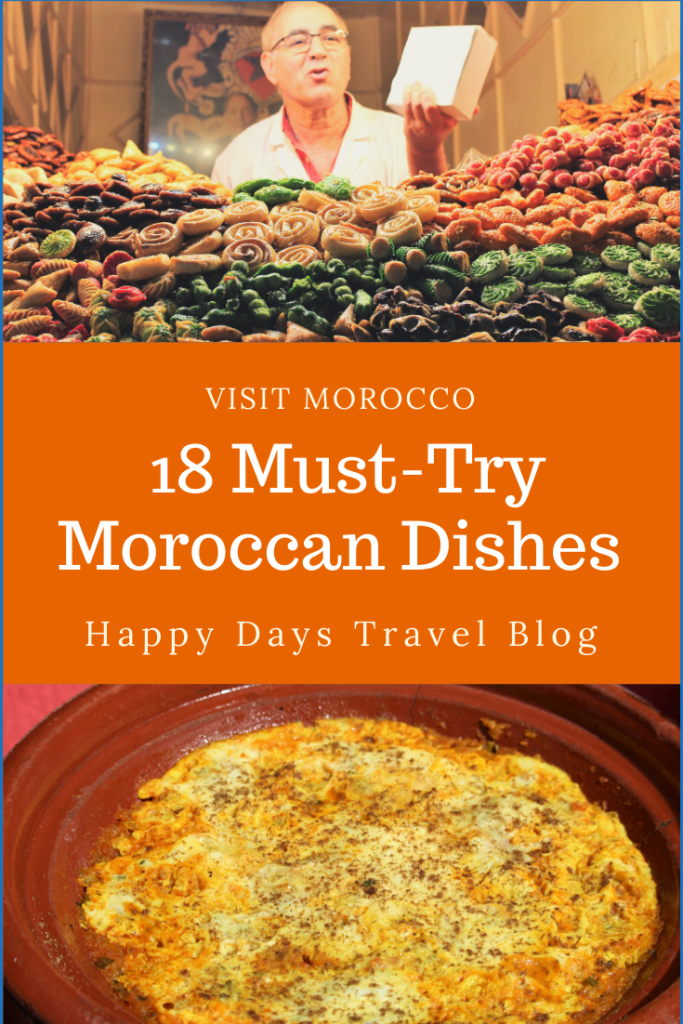
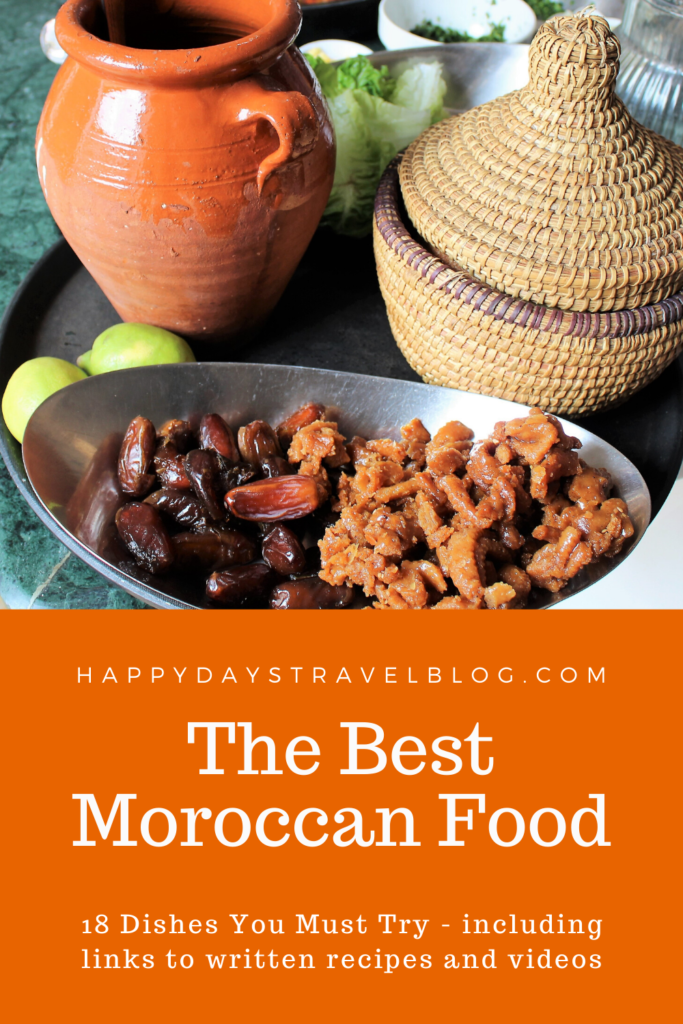
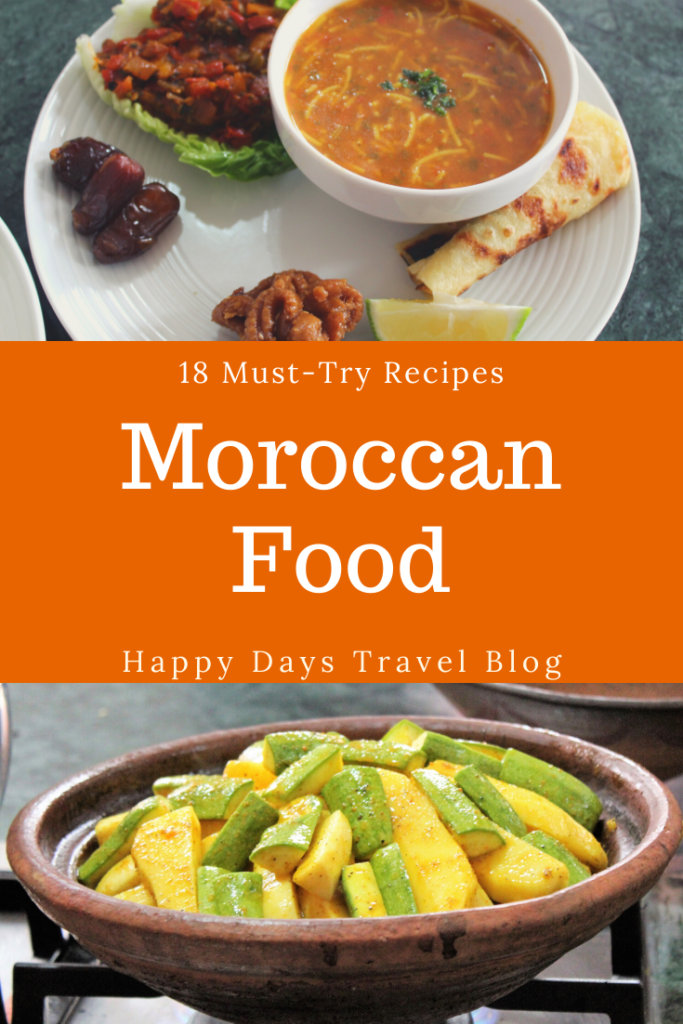
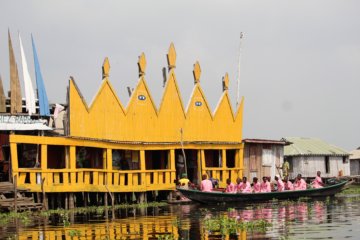
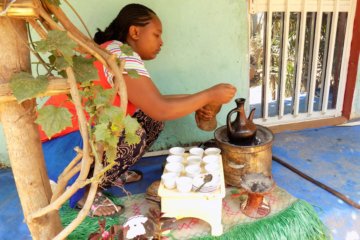
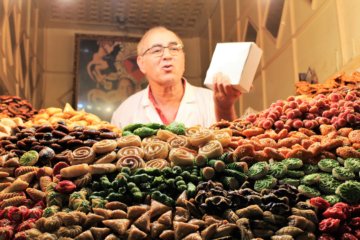


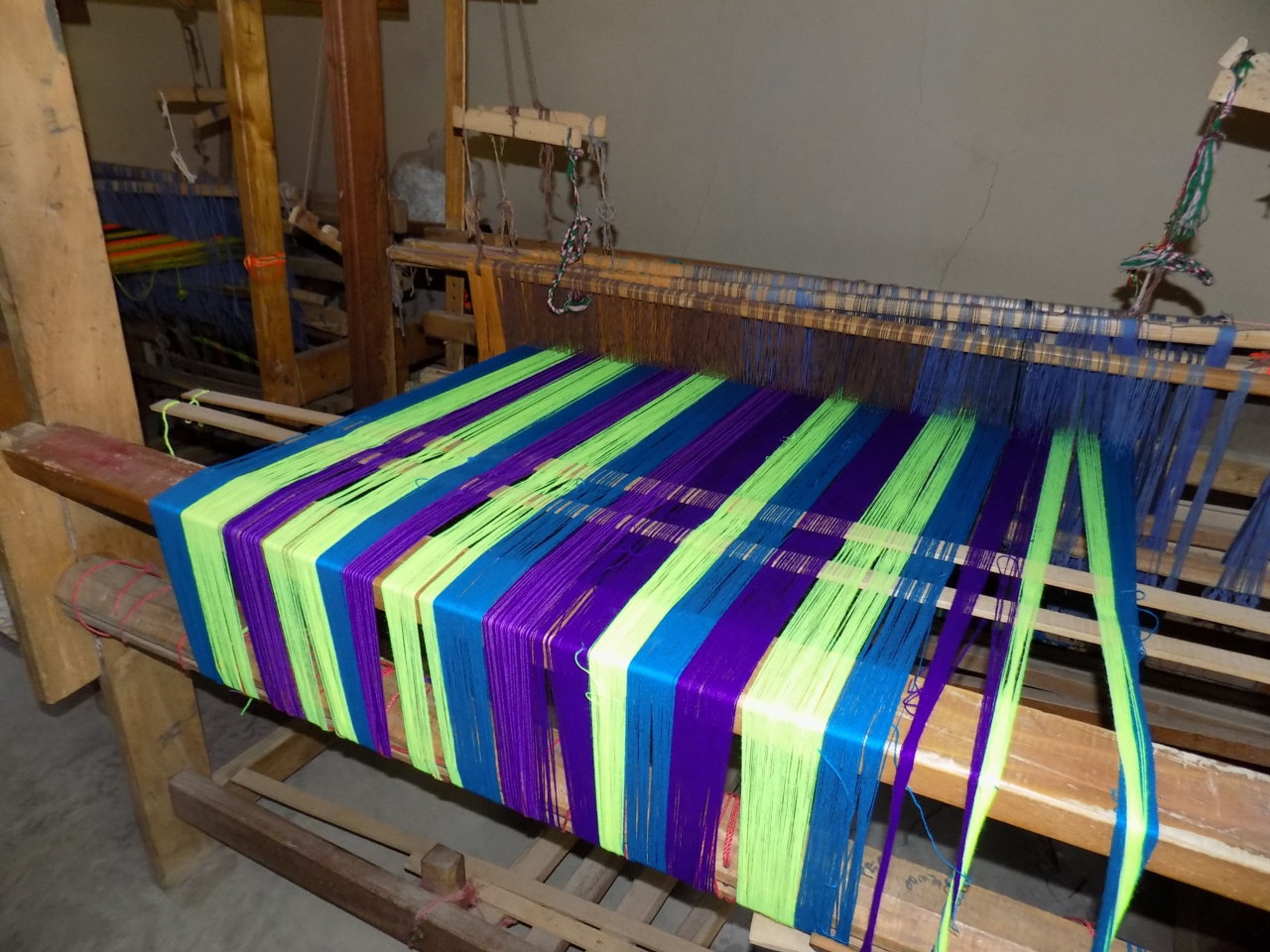





Oh wow, this food looks heavenly! If I only I could visit Morocco right now…
I can’t wait to go back!! Once all of this craziness is over! In the meantime, I’m cooking dishes inspired by our past travels.